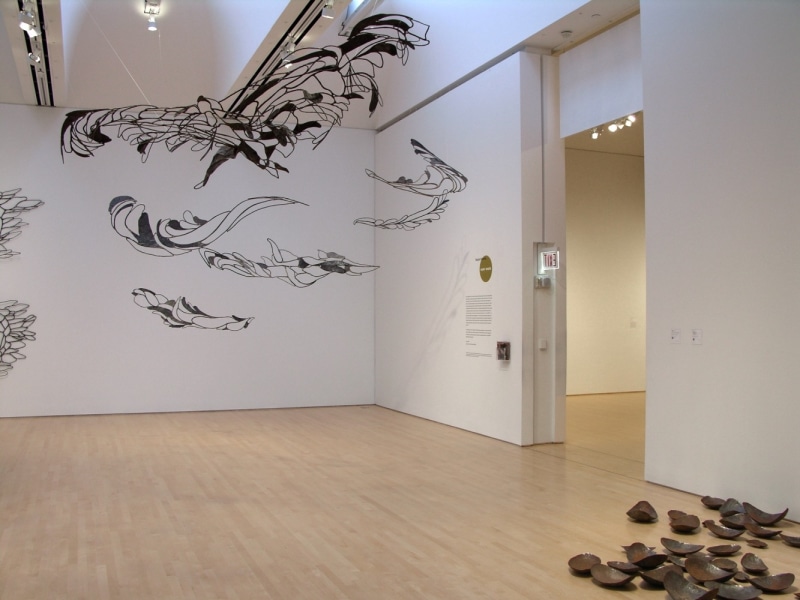
Though consisting of only six works, Ranjani Shettar’s current exhibition of recent works at SFMoMA shows off the depth and range of her capabilities. The sculptural installations and prints on display demonstrate her considerable technical agility. But it’s her wondrous imagination with its complex references to art and the world around her that really impresses. These references are often subtle to the point of abstruseness. Luckily, though, initial enjoyment of the pieces doesn’t require a knowledge or understanding of all the references. The lacy Sing Along consists of half a dozen or so wrapped wire pieces, all of which protrude from the gallery walls or hang from the ceiling. Hanging is a Shettar conceit. In Just a bit more (2005), the artist used bee’s wax and thread dipped in tea to express the beauty in humble materials; in Sun-sneezers blow light bubbles (2007-8) she first used the materials in Sing Along to contrast the fragility of bubble forms with the strength of the underlying armature. Shettar has remarked previously that the purpose of hanging a work is to engage gravity in its ultimate shape (downward tension dictates). Still, in regard to inspiration for hanging sculpture, one can’t help thinking of Calder‘s wire figures. The Sing Along grouping beckons viewers into its space; it creates an active environment with the gallery room, which promotes viewer exploration (rather than passive gazing) of the work. In this and other regards, Shettar carries on in the tradition of many post-minimalist artists, which though not linked together tightly enough to form a movement, have concerned themselves with incorporating the handmade with the repetitive, mechanicalness of traditional Minimalist work. Among those post-minimalist practices which Shettar adheres to are the use of every day objects (Tom Friedman), a focus on the sheer tactile beauty of an object (Anish Kapoor), as well construction of abstract forms through the hand-made “touch” (Eva Hesse, Martin Puryear). Shettar typically mixes industrial materials with traditional craft techniques, although she downplays too much meaning of the latter in her work. In an interview last year with John Eastman, she remarked: ” I am constantly observing materials around me and looking at possibilities. For me my materials do not have to always come from an art supply store, they could be from anywhere. I often look at craft material and also use craft techniques as they are generations old and refined. I use materials that can convey and add to my idea. . ."
Every material has uses and associations that are particular to each one of them and so they bring in their own meaning into works.” In the case of Sing Along, a wire armature is wrapped with muslin coated in tamarind paste, a glue used both in textile printing in India and in painting wood by the toymakers of Kinnala. Shettar made a special pilgrimage to this village to learn the technique. The textile element is subtle; without a close look at the piece, the pieces might be mistaken for iron or patina bronze. Sing Along takes its inspiration from the koel, the long-tailed cuckoo common in SE Asia and Australia, which, no doubt because of its distinctive call, was at one time a popular Indian cagebird. The koel is referred to as a “brood parasite,” because the female usually lays her single egg in the nests of other birds, sometimes removing existing host eggs beforehand. The host bird raises the fledging along with her chicks, apparently no one is ever the wiser. Other than the black finish of the sculpture, which mimics the male bird’s coat, there is nothing that overtly references this particular bird. Armed with deeper knowledge, one wonders what about the bird specifically inspired Shettar—was it the female’s speckled coat, its parasitic nature, the call? No matter, birds generally are in evidence throughout the piece. Once the source of the title is clear, feather shapes and spread wings abound.
-Venetian Red